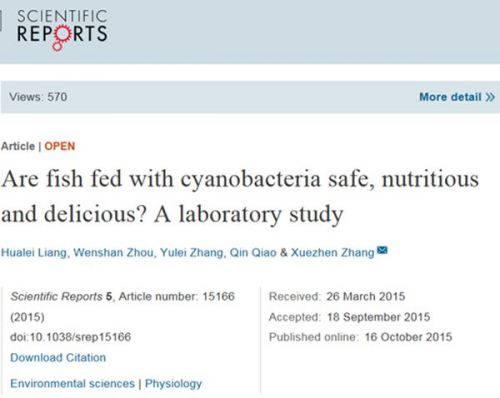
Recently, Scientific Reports publishes the latest research result by Aquatic Product Quality Safety Team in HZAU, Are fish fed with cyanobacteria safe, nutritious and delicious? A laboratory study by Doctor Liang Hualei, the first author, from the Fisheries College, and Assistant Professor Zhang Xuezhen, the corresponding author. The study reveals the result of using cyanobacteril powder as protein substitution and its significance for assessing the effect of cyanobacteria bloom on aquatic product quality safety
Worsening eutrophication worldwide leads to the frequent outbreaks of cyano- bacterial bloom, posing threats to fresh water and aquatic product quality safety. Microcystins ensuing the rapture of toxic cyanobacteria cells may cause the Microcystins standard to exceed the Tolerable Daily Intake (TDI) recommended by the World Health Organization (WHO).
Meanwhile, cyanobacteria, the earliest photoautotroph on the planet, is highly adaptive. Cyanobacteria contains 30-50% protein higher than that of soybean. Due to the scarcity of feed protein sources, scholars proposed to substitute cyanobacteria powder for protein. In our recent study, goldfish were fed cyanobacteria powder for 4 months with varying doses: 0% (control), 10%, 20%, 30% and 40%. Low doses (10% and 20%) promoted growth. However, high doses (30% and 40%) inhibited growth, compromising the muscle quality of the fish and giving them a pungent smell. It’s also found that the intake (EDI) of microcystins in muscle was close to or exceeded the TDI prescribed by the WHO.
Microcystins removal is essential to utilize cyanobacteria as protein substitution. Aquatic Product Quality Safety Team in HZAU has been devoted to issues that center around the proper use of microcystins for years and already made significant headway.
(By Li Ruibo)
http://news.hzau.edu.cn/2015/1120/43947.shtml
